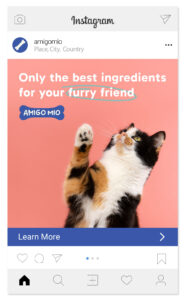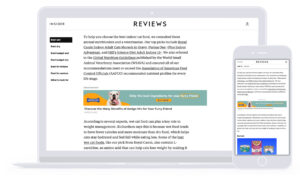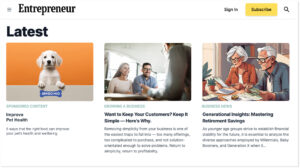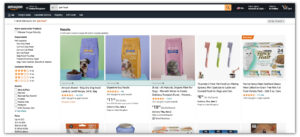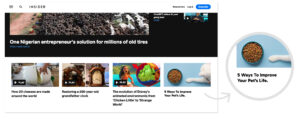Few tools of the digital age date as far back as display ads, with perhaps the exception of the internet itself. But that’s not to say that the state of display ads, and even the ads themselves, haven’t continued to evolve right alongside the rest of the online and mobile ecosystems. Today, in 2024, display advertising remains a dynamic discipline and an important overall piece of the digital advertising puzzle.
With this explainer, you’ll get a complete overview of the current state of display advertising — what it is, its benefits, how it’s evolved, and how brands and agencies can make the most of this essential tool within their larger omnichannel strategies.
Table of Contents
- What is Display Advertising?
- Does Display Advertising Still Work?
- Examples of Display Ads
- What Are the Main Types of Display Ads?
- What Are the Key Components of Display Ads?
- What are the Benefits of Display Ads?
- How to Create a Successful Display Ad Campaign?
What Is Display Advertising?
Display advertising is a form of online advertising that uses visual elements — whether that’s images, videos, graphics, or animations — to convey a marketing message or promote a product or service. These visual ads are typically displayed on websites, social media platforms, and mobile apps in various formats and sizes. The goal of display advertising is to attract the attention of the audience and drive them to take a specific action, such as clicking on the ad to visit a website, making a purchase, or signing up for a newsletter.
Does Display Advertising Still Work?
Display advertising, despite having come into existence in the mid-1990s, is still an effective and important part of the digital marketing toolbox. In 2023, advertisers in the United States were projected to spend more than $149 billion on programmatic digital display advertising. In 2024, that spending is expected to increase to more than $168 billion. Part of this growth is fueled by the impressive rise of retail media networks, which leverage display ads as a part of promoting products within e-commerce environments.
Although many within our industry point to low click-through rates on display ads as evidence that they do not “work,” this is an oversimplification of where display advertising can and should fit within the broader advertising ecosystem. Reasons display ads continue to be effective for brands and agencies include the following:
- Brand Awareness: Display ads are highly scalable and can reach a broad audience, increasing brand visibility and recognition, even among users who might not immediately convert.
- Targeting Capabilities: Modern display advertising platforms offer advanced targeting options, allowing advertisers to reach people based on specific demographics, interests, and behaviors — and even to retarget users who have previously interacted with their websites or apps.
- Cost-Efficiency: Display advertising can be cost-effective, especially when compared to traditional advertising channels like TV or print. Advertisers can control their budgets, set bidding strategies, and allocate resources to campaigns that generate the best returns.
- Complementing Other Marketing Channels: Display advertising can work in concert with other marketing channels, such as search advertising, social media marketing, and content marketing. When integrated into a holistic digital marketing strategy, display ads reinforce messaging and improve overall campaign performance.
While the effectiveness of display advertising can vary based on campaign strategy and industry, its adaptability, targeting capabilities, and potential for brand building continue to make it a valuable component of modern marketing efforts.
Examples of Display Ads
Skyscraper Ad

Here is an example of a 160×600 ad unit, also known as a skyscraper or super skyscraper ad. This unit appears on the side of a web page or content piece. Advertisers can use this ad size to engage audiences as they scroll down a page.
Banner Ad

This ad unit is 728 pixels wide and 90 pixels tall (728×90) and is one of the most common banner ads because of its usual placement. It is typically found at the top of a web page or content, enabling advertisers to immediately capture audience attention.
Medium Rectangle

The medium rectangle, which is 300 pixels wide and 250 pixels tall (300×2500, is arguably the most popular ad unit as it can be leveraged across desktops and mobile devices. Because of its size and shape, the medium rectangle can be embedded within content, allowing advertisers to drive impressions while audiences are actively engaged with content.
Mobile Standard
This ad banner is a 320×50 and is known as a mobile standard ad unit.
What Are the Main Types of Display Ads?
Having been in existence for nearly 30 years now, you might imagine that display ads have evolved quite a bit since they first hit the scene in 1994. These days, display ads take many forms, with organizations like IAB working hard to keep pace by establishing standards for these ad units. Let’s take a look at some of the main types of display ads, how users experience them, and the benefits of each.
Banner Ads
Banner ads are a ubiquitous presence in the digital landscape — and perhaps what advertisers most commonly think of when they hear the phrase “display ads.” These ads often appear at the top, bottom, or sides of web pages, demanding attention—and sometimes hindering the user experience. However, it’s important to acknowledge that not all banner ads are created equal.
While banner ads are often held up as the quintessential example of intrusive online advertising, they can be both informative and engaging, especially when the content is relevant to a user’s interests. For instance, a person shopping for a new laptop might appreciate a well-targeted banner ad showcasing the latest models and deals. In this way, banner ads can serve as a helpful tool for discovering products, services, or information that align with a user’s needs and preferences.
Despite their mixed reputation, banner ads offer a range of benefits for advertisers. For one, they provide a cost-effective way to reach a broad online audience and build brand awareness. With data-driven targeting strategies, marketers can ensure their ads are seen by the right audience, maximizing the return on investment. Banner ads also allow for creative flexibility, enabling marketers to convey their brand message through visuals, text, and multimedia elements. Furthermore, they facilitate tracking and measurement of ad performance, providing valuable insights into user engagement and conversion rates.
Retargeting Display Ads
Retargeting display ads, often referred to as remarketing ads, is a type of online advertising that targets users who have previously interacted with a website or online content but did not complete a desired action, such as making a purchase or filling out a form. These are the ads that famously “follow” people around the internet based on their activity. For this reason, they represent a bit of a polarizing topic. On one hand, retargeting ads can serve as helpful reminders, gently nudging users towards completing a purchase they may have abandoned or prompting them to revisit a site they’ve previously shown interest in. However, for some, this constant presence of retargeting ads can feel invasive and even creepy, as it can give the impression that their online activities are being closely monitored. Striking the right balance between reminding users of their interests and respecting their privacy is crucial for the success of retargeting campaigns.
Despite mixed perceptions of retargeting ads, they do offer substantial benefits for advertisers. As display ads go, they are particularly effective in converting prospects into actual customers, as they target individuals who have already shown an interest in a product or service. By focusing resources on a warm audience that is more likely to convert, they deliver a higher return on investment than traditional display ads.
Native Ads
Native display ads provide a distinct and often more seamless experience for users compared to banner ads and other traditional display ads, which typically appear around the content a user is seeking. Native display ads are designed to blend in with the content and style of the website or platform on which they appear, making them less obtrusive.
By seamlessly integrating with the surrounding content, native ads can enhance user engagement and generate higher click-through rates. They also have the potential to improve brand perception, as they are typically more informative than traditional display ads. Additionally, native advertising can provide valuable storytelling opportunities, allowing brands to communicate their message in a contextually relevant and engaging way.
Social Ads
Social display ads, as the name suggests, are integrated into the user experience on social media platforms. They might appear around a user’s social feed, or even directly in it. These ads are typically targeted based on a user’s interests, demographics, and online behavior, which means users are more likely to see content that aligns with their preferences.
These ads provide an effective way to reach a highly targeted audience, leveraging the extensive user data and demographic information available on social media platforms. Additionally, social display ads often offer interactive elements, such as “Shop Now” buttons or forms for lead generation, which can drive direct conversions.
Video Ads
Video advertising can take many shapes, including within the context of a display ad. Banner-style ads that contain video are eye-catching and enable brands to enhance their storytelling and get greater mileage out of their branded video assets. In general, video is a highly engaging medium that can convey complex information and evoke emotions effectively. In the context of a display ad, however, it must be used wisely, given the limited attention users are often willing to give to display ads appearing outside the content they’re consuming.
Discovery Ads
Discovery Ads are a form of display advertising that enables brands to reach a wide audience across Google-owned properties and partner platforms like Google Discover, YouTube, and Gmail. These ads leverage machine learning and user data to provide personalized content recommendations, making them highly relevant to individual users based on their interests and online behavior.
What Are the Key Components of Display Ads?
While display ads can take many forms and appear in many different places, they typically contain three core elements:
1. Visuals
The goal of a display ad is to capture a user’s attention, even though they’ve come to a web page with a separate purpose in mind. Thus, compelling visuals are key. That said, standard display ad sizes, as defined by the IAB, vary greatly, meaning advertisers must be discerning in terms of how much they try to accomplish within the space they have. Core concepts to keep in mind include:
- High-Quality Imagery: Use high-resolution images or graphics that are clear, sharp, and visually appealing. Blurry or pixelated visuals can make your ad appear unprofessional.
- Relevance: Ensure that the visuals directly relate to your product, service, or message. The imagery should immediately convey what the ad is about and capture the viewer’s attention.
- Consistency: Maintain a consistent visual style and branding across all your ad creatives. This helps build brand recognition and trust.
- Simplicity: Keep the design clean and uncluttered. Too many elements or a busy layout can confuse viewers and detract from the message.
2. Copy
While visuals get noticed first, copy represents the meat of the ad. If you’re lucky enough to have a user notice your ad, make sure the copy is compelling, adheres to your brand promise, and effectively guides them to your call to action.
3. Call to Action (CTA)
A strong call to action (CTA) in a display ad is essential for encouraging user engagement and achieving your campaign objectives. Here are some examples of effective CTAs for display ads:
- Shop Now: This CTA is commonly used in ecommerce ads and encourages users to make a purchase.
- Learn More: Use this CTA when you want to provide additional information about a product, service, or offer.
- Get Started: This CTA is effective for ads promoting sign-ups, free trials, or onboarding processes.
- Book Now: This CTA is commonly used in the travel and hospitality industry to prompt users to make reservations.
- Contact Us: This CTA is suitable for businesses that want users to reach out for inquiries or support.
- Claim Your Reward: This CTA is effective for loyalty programs, rewards, or promotions.
- Get Your Deal: Also useful for e-commerce promotions, this CTA is used to highlight special offers or discounts.
What are the Benefits of Display Ads?
The display ad market can be competitive — but for good reason. Here are some of the key benefits provided by strong display ads:
They’re Targeted
To ensure your marketing dollars are being used efficiently, you need to make sure you’re marketing to the right audience. With display ads, you can pinpoint exactly the audience you want to reach, down to even the most specific niche.
They’re Personal
Given the targeting potential behind display ads, these campaigns let you cater to your audience with personalized creative that maximizes your chance of scoring a conversion.
They Drive Brand Awareness
As marketers well know, consumers must encounter a brand’s message multiple times before it starts to sink in and move them toward conversion. Even if a user doesn’t click through to your website, display ads can put your company’s visual identity in front of enough people to have a brand-boosting impact.
They Can Be Effectively Tracked
There’s no shortage of insight to be gleaned from a display ad campaign. If you’re running multiple campaigns, you can easily see which has been viewed the most and which has performed the best — all in real time. Such insights are invaluable to optimizing efforts not just on display ads, but also throughout an omnichannel campaign.
How to Create a Successful Display Ad Campaign
Display ads represent a foundation of digital advertising efforts, and the best results are seen when marketers put in time and effort on developing a thoughtful strategy. It takes multiple steps and ongoing optimization to help a display campaign reach its full potential. To lay the right foundation, be sure these key steps are given proper attention:
Define Your Target Audience — as Specifically as Possible
Defining your target audience for a display ad campaign is a crucial first step. Start by analyzing your existing customer data and market research to identify demographics, interests, behaviors, and pain points. Create detailed buyer personas representing your ideal customers, taking into account factors like age, gender, location, income, preferences, and online habits. Consider your product or service’s unique selling points and tailor your messaging to address the specific needs and aspirations of your target audience.
Outline Your Campaign’s Goals and Budget
When planning your display ad campaign, setting clear goals and budget parameters is essential. Begin by defining your campaign objectives, whether it’s increasing brand awareness, driving website traffic, boosting sales, or achieving a specific conversion rate. Once your goals are established, allocate a budget that aligns with your objectives and the expected costs of reaching your target audience effectively. Consider factors such as ad spend, creative production costs, and any associated expenses. By regularly monitoring your campaign’s performance against these goals and budget, you can make necessary adjustments and optimize your ad spend in real time for the best results.
Craft Compelling Creative
Crafting compelling creative for a display ad campaign is essential for capturing audience attention. Start by creating visually striking imagery or graphics that align with your brand identity and campaign objectives. Use concise, persuasive copy that communicates a clear and enticing message, and be sure to highlight unique selling points, offers, or benefits to grab viewers’ interest quickly. Incorporate a strong CTA that guides users on what action to take next, and ensure that the creative elements are responsive to different screen sizes and devices to guarantee a seamless user experience. By then A/B testing various ad creatives, you can identify which visuals and messaging resonate most effectively with your target audience.
Display Advertising: A Valuable Approach to Driving Consumer Engagement
A lot of work goes into a strong display advertising program. Anything less will result in not only poor performance but also wasted ad spend. But now that you understand how to best leverage your display assets to capture attention and drive engagement, you’re ready to launch a winning campaign.
Check back with Digilant regularly for additional content and insights that can help you make the most of your budget and creative assets.








